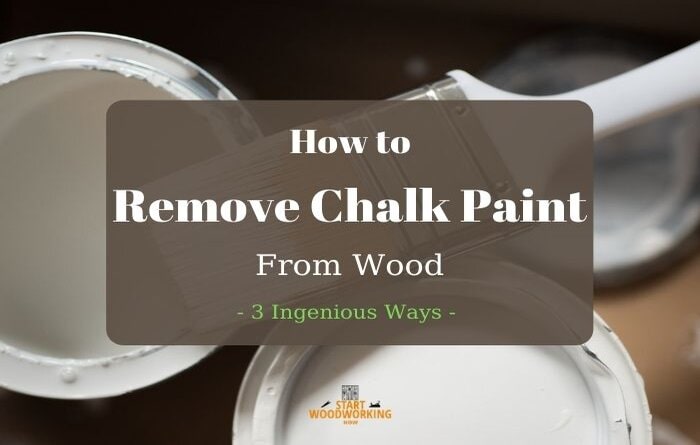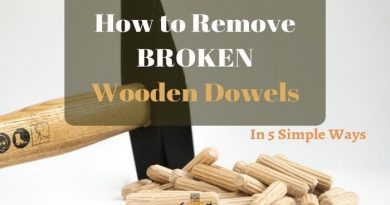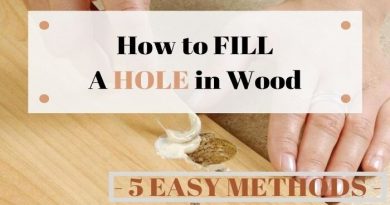How To Remove Chalk Paint From Wood [3 Ingenious Ways]
When it comes to removing chalk paint from wood, it is best to have preparation in advance and be able to react to any problem with ease and not end up making a disaster for not knowing how to remove it either dry or freshly applied.
To remove chalk paint from wood follow these steps:
- Remove the layer of wax from the chalk paint
- Using a sponge or cloth rub the remaining chalk paint from the wood
- To remove more chalk paint residue from the wood surface use a ball of steel wool.
- Rinse and let the wood surface dry.
- Using sandpaper sand the remaining chalk stains.
- Clean the wood surface with a lint-free cloth.
Step-by-Step Guide to Remove Chalk Paint from Wood
Things You’ll Need:
- chemical impregnation for cleaning surfaces from paints and varnishes
- hair dryer used for construction purposes
- grinder with a grinding disc or drill with an abrasive attachment
- sandpaper, small spatulas
- protective equipment against toxic substances
Step 1. Remove the old paint already applied
We start with a sponge and water, perhaps adding thinner
Depending on the situation, the basic materials will often be enough to carry out this step, which is to remove as best as possible the layer of chalk paint already applied and that is dry, and even damaged or worn.
For this, water and a regular sponge should be enough, but if not, you can add some paint thinner to the water.
Chalk paint usually comes off easily if you insist on using a lot of sponge and water strokes, but thinner may be necessary on certain surfaces.
Replace the water if you see that it fills with paint, because the cleaner the water, the more capacity it will have to absorb the paint that is progressively removed. It is also advisable to clean the sponge.
Step 2. Sand and clean the wood
At this point, the wood will be visible because we have got rid of a large portion of the chalk paint layer.
Once we remove most of the paint layer, we proceed to remove the rest with the steel sponge, which will take care of it without problems.
Here you can use warm water (not hot, much less boiling, because it can damage the wood) to help you if you see that there are still parts with a lot of chalk paint that resist cleaning.
Step 3. Give a good finish to the wood
We are already in the last stage, whoever wants to can reapply a little more paint thinner, but this time with the lint-free cloth, so we do not spoil the smooth surface in the previous step, but in turn, we clean a little plus the painting that was previously there.
If you have applied thinner, you should let the furniture dry before proceeding.
Once we have the furniture dry, we use the lint-free cleaning cloth again, but this time applying Danish oil or any oil that fulfills the same function.
You can apply several layers, allowing a few hours between each one to dry and apply correctly. This step is not strictly necessary but allows for a better end result.
Lastly, it is not necessary to apply the wax or varnish, according to personal preference, to protect the wood surface and add a certain level of shine, if desired.
When the wax or varnish has dried, you will have your furniture without chalk paint and with a good finish.
3 Methods How to Remove Chalk Paint from Wood
Basically, there are three different methods how to remove chalk paint from wood:
- Mechanically. That is, with sandpaper, either by hand or with the blessed electric sander
- With chemical products. Strippers for varnishes and paints. For the shellac, 96º alcohol; for finishes with wax, specific dewaxing products or spirit of turpentine
- With heat. Heat gun.
| Mechanical | Thermal | Chemical |
| spatula chisel sandpaper hard metal brush grinder drill or grinder with nozzles | Torch burner Hair dryer Steam iron | Solvents Paint thinners |
Whichever method you choose, the wood surface is subject to heavy wear. Therefore treat the surface with a wood oil or with a new coat of paint after removing the paint.
#1. Remove Chalk Paint Using Mechanical Method
One of the most common ways to remove chalk paint from wood is by sanding.
This is one of the most common options for removing thin layers of material. Usually sandpaper is used manually, with a block of wood or rubber, so as not to warp the surface and put more pressure on it.
For thicker layers, corners and furniture, the use of an orbital sander is more recommended.
With manual sanders, the job is done faster and with less physical effort.
For wood floors or hard surfaces and less maintenance is used the belt sander, with which to remove harder materials, and remove layers of thicker materials, including polishing the wood to renew its color.
Sanding is not recommended for delicate furniture and soft woods, it can scratch the wood too much and cause ripples or injure edges and moldings.
Keep in mind that chalk paint is dusty , so protect yourself with a mask and do it in a ventilated place, protecting the furniture around you.
Steps for removing chalk paint with sanding:
- Start with coarse sandpaper, preferably 80 grit .
- Remove as much old paint as possible, avoiding warping in the corners and edges.
- Sand the entire surface gently.
- Treat hard-to-reach spots and corners with the scraper.
- Continue using finer sandpaper; 120 grit paper is recommended.
- Then repaint the wood.
- Finish with a fine sandpaper to polish the wood, removing paint marks and scratches from the previous pass.
Advantages and disadvantages of removing chalk paint from wood with sandpaper:
Keep in mind that sandpaper, especially if you use an electric sander with a coarse grit sandpaper, will remove varnishes and paints with relative ease, but if you act on the wood it will leave grooves that will be very difficult to disguise.
I only recommend it if you don’t feel like working a lot and then you’re going to paint over it.
#2. Remove Chalk Paint Using Chemical Method
This is the best method for wood with moldings, engravings, and curved surfaces.
To remove the chalk paint from wood, it is possible to use steel shavings, a metallic kitchen sponge, or a steel brush with very fine bristles.
It is also the perfect method for chalk paint in very poor condition, and surfaces with thick or thin layers of paint.
Paint strippers or strippers are very aggressive chemicals. It is very important to take special care with delicate objects and furniture, as it can soften the wood and loosen the glued joints.
Follow this amazing guide I wrote on how to remove dried glue your wooden furniture!
We also recommend taking the necessary safety measures to avoid accidents: use gloves for chemicals, glasses, long sleeves, and carry out work outdoors or in ventilated areas.
Steps to remove chalk paint from wood with stripper:
- Apply the product with a brush and let it act between 15 minutes and half an hour.
- When the paint wrinkles and peels off the surface, remove it with a spatula or chip.
- Without traces of paint, rinse with water to remove excess chemicals.
- Finally sand manually with fine sandpaper to smooth the wood.
Pros: fast, comfortable, economical.
Cons: toxicity.
Advantages and disadvantages of removing chalk paint from wood using stripper method:
It is my favorite method for delicate and historical furniture , since, well used, it does not damage the wood, but you have to be very careful with it for several reasons: if you leave drops pouring more than it should, the wood will stain.
It is also the most cumbersome to work with since the remains of varnish / paint with the stripping gel make a sticky mass that can be difficult to control.
But if you work carefully and follow some minimal guidelines, it seems like the best solution.
#3. Remove Chalk Paint using the Thermal Method
One of the main advantages of using a heat gun is to avoid toxic dust and fumes caused by the above two methods.
It is a recommended technique for removing many coats of paint, but also less. The process can be slower and special care should be taken not to burn the wood, which will cause irreparable stains on the surface.
* Thick work gloves made of leather (not plastic!)
* Protective goggles are the minimum equipment.
The thermal method is similar in its effect on paint to the chemical one, only instead of a wash, a special construction hair dryer is used.
A jet of hot air is directed to the surface covered with paint, as a result of which the coating heats up, softens and peels off.
Some models of building hair dryers have nozzles with scraper, this makes it possible to heat and remove paint at the same time.
When working with the thermal method, it is necessary to remove the chalk paint immediately after it has softened, avoiding burning.
It should also be borne in mind that heating has a bad effect on many paint coatings, and if such a layer is the lowest, then it will not work to remove it.
The wooden surface under the paint will burn, but the coating will remain. And then it is easier to remove it with a simple plane.
Steps to remove chalk paint from wood using a heat gun:
- Apply heat to the surface of about 10 to 15 centimeters, with an inclination of about 45 degrees.
- When the paint begins to crease, remove it with a spatula or scraper, being careful not to damage the wood.
- To avoid damaging the wood surface when peeling off the paint, you need to scrape along the grain of the wood.
- Use narrow chisels or scrapers in hard-to-reach places
- Repeat the operation if necessary.
- Finally, sand to remove chalk paint residue and smooth the surface.
Pros: inexpensive, availability of tools.
Cons: Long, surface damage may occur.
When it is necessary to remove chalk paint from wood?
- When in very poor condition, peel or peel. Otherwise, applying a coat of chalk paint into the old coat under poor conditions will not provide adequate adhesion, in addition to achieving a terrible finish.
- To renew the layer of varnish which is cracked, which has changed color or which has detached from the support. It also renews the original color of the wood.
- Remove the layer of color , then varnish or wax, showing the grain and natural tones of the wood.
- When a product incompatible with the previous one will be applied. For example, chalk paint over polyurethane varnish.
Can I remove chalk paint from wood without leaving any residue?
Furniture or tiles painted with chalk paint will definitely get rid of the chalk paint.
But be careful: if you are not used to using the random orbit sander, this can result in unsightly marks in the wood. Certain woods such as oak are very sensitive to paint strippers and will not regain their original color afterwards.
Chalk paint that is still damp can simply be wiped off from wood with warm water and a cloth. Beware of chalk stains on clothing and other textiles. The chalk paint can only be removed when it is still damp.




